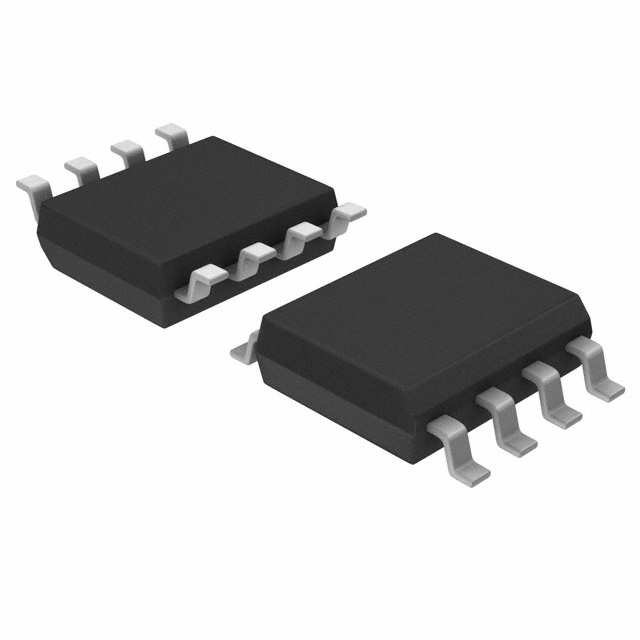Lihat spesifikasi untuk detail produk.

DS90LV027ATMX
Product Overview
Category
The DS90LV027ATMX belongs to the category of high-speed differential line drivers and receivers.
Use
It is primarily used for transmitting and receiving high-speed digital signals over long distances.
Characteristics
- High-speed operation: The DS90LV027ATMX supports data rates up to 400 Mbps.
- Low power consumption: It operates at a low supply voltage and consumes minimal power.
- Differential signaling: It uses differential signaling to provide noise immunity and reduce electromagnetic interference (EMI).
- Wide temperature range: The device can operate in a wide temperature range, making it suitable for various environments.
Package
The DS90LV027ATMX is available in a small form factor package, such as a 16-pin TSSOP (Thin Shrink Small Outline Package).
Essence
The essence of the DS90LV027ATMX lies in its ability to transmit and receive high-speed digital signals reliably over long distances while maintaining signal integrity.
Packaging/Quantity
The DS90LV027ATMX is typically packaged in reels or tubes, with a quantity of 2500 units per reel/tube.
Specifications
- Supply Voltage Range: 3.0V to 3.6V
- Data Rate: Up to 400 Mbps
- Operating Temperature Range: -40°C to +85°C
- Input Common Mode Voltage Range: -1V to +2V
- Output Voltage Swing: 350mV (minimum)
- Power Consumption: 10mW (typical)
Detailed Pin Configuration
The DS90LV027ATMX has a total of 16 pins, which are assigned specific functions. The pin configuration is as follows:
- VCC
- GND
- RXP
- RXN
- RXDLYP
- RXDLYN
- RXDIS
- VREF
- TXP
- TXN
- TXDLYP
- TXDLYN
- TXDIS
- NC
- NC
- GND
Functional Features
- Differential Line Driver: The DS90LV027ATMX provides a high-speed differential line driver that converts digital signals into differential voltage signals suitable for transmission over long distances.
- Differential Line Receiver: It also includes a differential line receiver that converts the received differential voltage signals back into digital signals.
- Built-in Delay Control: The device features built-in delay control to compensate for signal propagation delays, ensuring accurate data transmission and reception.
- Enable/Disable Function: The enable/disable function allows the user to control the transmission and reception of data.
Advantages and Disadvantages
Advantages
- High-speed operation enables reliable transmission of digital signals at high data rates.
- Low power consumption makes it suitable for battery-powered applications.
- Differential signaling provides noise immunity and reduces electromagnetic interference.
- Wide temperature range allows for operation in various environments.
Disadvantages
- Limited pin configuration options may restrict certain application requirements.
- Requires external components for proper operation, such as termination resistors.
Working Principles
The DS90LV027ATMX operates based on the principles of differential signaling. It uses two complementary signals, one positive (TXP) and one negative (TXN), to represent digital data. These signals are transmitted differentially over a twisted pair of wires, which helps minimize noise and maintain signal integrity.
On the receiving end, the differential signals (RXP and RXN) are converted back into digital signals using a differential line receiver. The receiver compares the voltage difference between the two signals and determines the logic level of the received data.
The device also incorporates delay control to compensate for signal propagation delays, ensuring accurate data transmission and reception.
Detailed Application Field Plans
The DS90LV027ATMX finds applications in various fields where high-speed digital signal transmission is required. Some of the potential application areas include:
- Industrial Automation: The device can be used in industrial automation systems to transmit control signals over long distances reliably.
- Telecommunications: It can be employed in telecommunications equipment for transmitting high-speed data between network components.
- Automotive Electronics: The DS90LV027ATMX can be utilized in automotive electronics to enable high-speed communication between different vehicle modules.
- Medical Equipment: It finds use in medical equipment where high-speed data transmission is crucial, such as in imaging systems or patient monitoring devices.
Detailed and Complete Alternative Models
- SN65LVDS31: A similar differential line driver and receiver with comparable specifications.
- MAX9126: Another high-speed differential line driver and receiver suitable for long-distance signal transmission.
- DS90LV048A: A higher channel count differential line driver and receiver for applications requiring multiple data lines.
(Note: This list is not exhaustive and there may be other alternative models available in the market.)
In
Sebutkan 10 pertanyaan dan jawaban umum terkait penerapan DS90LV027ATMX dalam solusi teknis
Sure! Here are 10 common questions and answers related to the application of DS90LV027ATMX in technical solutions:
1. What is DS90LV027ATMX? - DS90LV027ATMX is a high-speed differential line driver/receiver commonly used in technical solutions for transmitting and receiving data over long distances.
2. What is the maximum data rate supported by DS90LV027ATMX? - The maximum data rate supported by DS90LV027ATMX is 400 Mbps.
3. Can DS90LV027ATMX be used for point-to-point communication? - Yes, DS90LV027ATMX can be used for point-to-point communication as it provides a differential signaling interface.
4. What is the operating voltage range of DS90LV027ATMX? - The operating voltage range of DS90LV027ATMX is typically between 3.0V and 3.6V.
5. Is DS90LV027ATMX compatible with LVDS (Low Voltage Differential Signaling) standards? - Yes, DS90LV027ATMX is fully compatible with LVDS standards.
6. Can DS90LV027ATMX be used in industrial applications? - Yes, DS90LV027ATMX is suitable for industrial applications due to its robustness and noise immunity.
7. Does DS90LV027ATMX support hot-plugging of devices? - No, DS90LV027ATMX does not support hot-plugging. It is recommended to power off the device before connecting or disconnecting it.
8. What is the typical power consumption of DS90LV027ATMX? - The typical power consumption of DS90LV027ATMX is around 100mW.
9. Can DS90LV027ATMX be used in automotive applications? - Yes, DS90LV027ATMX is automotive-grade and can be used in automotive applications.
10. What is the recommended PCB layout for DS90LV027ATMX? - The datasheet of DS90LV027ATMX provides guidelines for the recommended PCB layout, including proper termination and signal integrity considerations.
Please note that these answers are general and it's always recommended to refer to the specific datasheet and application notes for detailed information and guidelines.

